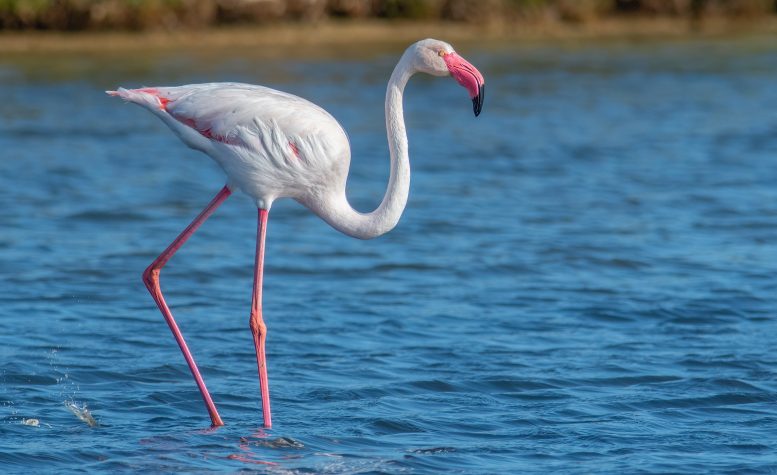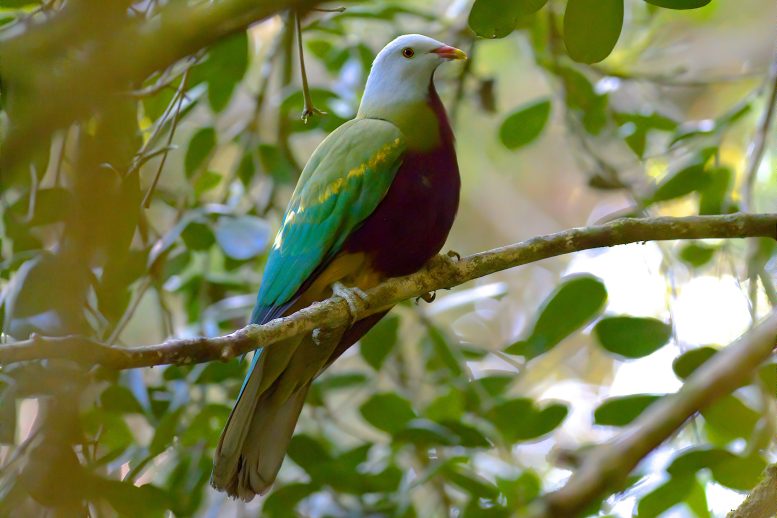An enormous meteor spelled doom for most dinosaurs 65 million years ago. But not all. In the aftermath of the extinction event, birds — technically dinosaurs themselves — flourished.
Scientists have spent centuries trying to organize and sort some 10,000 species of birds into one clear family tree to understand how the last surviving dinosaurs filled the skies. Cheap DNA sequencing should have made this simple, as it has for countless other species.
But birds were prepared to deceive us.
In a pair of new research papers released today, April 1, scientists reveal that another event 65 million years ago misled them about the true family history of birds. They discovered that a section of one chromosome spent millions of years frozen in time, and it refused to mix together with nearby DNA as it should have.
This section, just two percent of the bird genome, convinced scientists that most birds could be grouped into two major categories, with flamingos and doves as evolutionary cousins. The more accurate family tree, which accounts for the misleading section of the genome, identifies four main groups and identifies flamingos and doves as more distantly related.
A greater flamingo in Mallorca, Spain. Unraveling a genetic mystery revealed that flamingos and doves are more distantly related than previously thought. Credit: Daniel J. Field
Breakthrough in Bird Evolution Research
"My lab has been chipping away at this problem of bird evolution for longer than I want to think about," said Edward Braun, Ph.D., the senior author of the paper published in the Proceedings of the National Academy of Sciences and a professor of biology at the University of Florida. "We had no idea there would be a big chunk of the genome that behaved unusually. We kind of stumbled onto it."
Braun supervised an international team of collaborators led by Siavash Mirarab, a professor of computer engineering at the University of California San Diego, to publish their evidence that this sticky chunk of DNA muddied the true history of bird evolution. Mirarab and Braun also contributed to a companion paper published in Nature that outlines the updated bird family tree, which was led by Josefin Stiller at the University of Copenhagen.
Both papers are part of the B10K avian genomics project led by Guojie Zhang of Zhejiang University, Erich Jarvis of Rockefeller University, and Tom Gilbert of the University of Copenhagen.
Two mutually exclusive bird family trees. The top family tree lumps flamingos and doves, in blue and teal respectively, closely together, while the bottom family tree does not. The top family tree was built around distortions in bird genomes that date back to the extinction of the dinosaurs. The bottom family tree is likely more accurate, after accounting for these genomic anomalies. Credit: Edward Braun
Genetic Anomalies and Evolutionary Insights
Ten years ago, Braun and his collaborators pieced together a family tree for the Neoaves, a group that includes the vast majority of bird species. Based on the genomes of 48 species, they split the Neoaves into two big categories: doves and flamingos in one group, all the rest in the other. When repeating a similar analysis this year using 363 species, a different family tree emerged that split up doves and flamingos into two distinct groups.
With two mutually exclusive family trees in hand, the scientists went hunting for explanations that could tell them which tree was correct.
"When we looked at the individual genes and what tree they supported, all of a sudden it popped out that all the genes that support the older tree, they're all in one spot. That's what started the whole thing," Braun said.
Investigating this spot, Braun's team noticed it was not as mixed together as it should have been over millions of years of sexual reproduction. Like humans, birds combine genes from a father and a mother into the next generation. But birds and humans alike first mix the genes they inherited from their parents when creating sperm and eggs. This process is called recombination, and it maximizes a species' genetic diversity by making sure no two siblings are quite the same.
A wompoo fruit-dove in Queensland, Australia. Unraveling a genetic mystery revealed that flamingos and doves are more distantly related than previously thought. Credit: Daniel J. Field
Braun's team found evidence that one section of one bird chromosome had suppressed this recombination process for a few million years around the time the dinosaurs disappeared. Whether the extinction event and the genomic anomalies are related is unclear.
The result was that the flamingos and doves looked similar to one another in this chunk of frozen DNA. But taking into account the full genome, it became clear that the two groups are more distantly related.
"What's surprising is that this period of suppressed recombination could mislead the analysis," Braun said. "And because it could mislead the analysis, it was actually detectable more than 60 million years in the future. That's the cool part."
Such a mystery could be lurking in the genomes of other organisms as well.
"We discovered this misleading region in birds because we put a lot of energy into sequencing birds' genomes," Braun said. "I think there are cases like this out there for other species that are just not known right now."
References:
"Complexity of avian evolution revealed by family-level genomes" by Josefin Stiller, Shaohong Feng, Al-Aabid Chowdhury, Iker Rivas-González, David A. Duchêne, Qi Fang, Yuan Deng, Alexey Kozlov, Alexandros Stamatakis, Santiago Claramunt, Jacqueline M. T. Nguyen, Simon Y. W. Ho, Brant C. Faircloth, Julia Haag, Peter Houde, Joel Cracraft, Metin Balaban, Uyen Mai, Guangji Chen, Rongsheng Gao, Chengran Zhou, Yulong Xie, Zijian Huang, Zhen Cao, Zhi Yan, Huw A. Ogilvie, Luay Nakhleh, Bent Lindow, Benoit Morel, Jon Fjeldså, Peter A. Hosner, Rute R. da Fonseca, Bent Petersen, Joseph A. Tobias, Tamás Székely, Jonathan David Kennedy, Andrew Hart Reeve, Andras Liker, Martin Stervander, Agostinho Antunes, Dieter Thomas Tietze, Mads Bertelsen, Fumin Lei, Carsten Rahbek, Gary R. Graves, Mikkel H. Schierup, Tandy Warnow, Edward L. Braun, M. Thomas P. Gilbert, Erich D. Jarvis, Siavash Mirarab and Guojie Zhang, 32 March 2024, Nature.
DOI: 10.1038/s41586-024-07323-1
"A region of suppressed recombination misleads neoavian phylogenomics" by Siavash Mirarab, Iker Rivas-González, Shaohong Feng, Josefin Stiller, Qi Fang, Uyen Mai, Glenn Hickey, Guangji Chen, Nadolina Brajuka, Olivier Fedrigo, Giulio Formenti, Jochen B. W. Wolf, Kerstin Howe, Agostinho Antunes, Mikkel H. Schierup, Benedict Paten, Erich D. Jarvis, Guojie Zhang and Edward L. Braun, 1 April 2024, Proceedings of the National Academy of Sciences.
DOI: 10.1073/pnas.2319506121
This work was supported in part by the National Science Foundation.
News
New mRNA therapy targets drug-resistant pneumonia
Bacteria that multiply on surfaces are a major headache in health care when they gain a foothold on, for example, implants or in catheters. Researchers at Chalmers University of Technology in Sweden have found [...]
Current Heart Health Guidelines Are Failing To Catch a Deadly Genetic Killer
New research reveals that standard screening misses most people with a common inherited cholesterol disorder. A Mayo Clinic study reports that current genetic screening guidelines overlook most people who have familial hypercholesterolemia, an inherited disorder that [...]
Scientists Identify the Evolutionary “Purpose” of Consciousness
Summary: Researchers at Ruhr University Bochum explore why consciousness evolved and why different species developed it in distinct ways. By comparing humans with birds, they show that complex awareness may arise through different neural architectures yet [...]
Novel mRNA therapy curbs antibiotic-resistant infections in preclinical lung models
Researchers at the Icahn School of Medicine at Mount Sinai and collaborators have reported early success with a novel mRNA-based therapy designed to combat antibiotic-resistant bacteria. The findings, published in Nature Biotechnology, show that in [...]
New skin-permeable polymer delivers insulin without needles
A breakthrough zwitterionic polymer slips through the skin’s toughest barriers, carrying insulin deep into tissue and normalizing blood sugar, offering patients a painless alternative to daily injections. A recent study published in the journal Nature examines [...]
Multifunctional Nanogels: A Breakthrough in Antibacterial Strategies
Antibiotic resistance is a growing concern - from human health to crop survival. A new study successfully uses nanogels to target and almost entirely inhibit the bacteria P. Aeruginosa. Recently published in Angewandte Chemie, the study [...]
Nanoflowers rejuvenate old and damaged human cells by replacing their mitochondria
Biomedical researchers at Texas A&M University may have discovered a way to stop or even reverse the decline of cellular energy production—a finding that could have revolutionary effects across medicine. Dr. Akhilesh K. Gaharwar [...]
The Stunning New Push to Protect the Invisible 99% of Life
Scientists worldwide have joined forces to build the first-ever roadmap for conserving Earth’s vast invisible majority—microbes. Their new IUCN Specialist Group reframes conservation by elevating microbial life to the same urgency as plants and [...]
Scientists Find a Way to Help the Brain Clear Alzheimer’s Plaques Naturally
Scientists have discovered that the brain may have a built-in way to fight Alzheimer’s. By activating a protein called Sox9, researchers were able to switch on star-shaped brain cells known as astrocytes and turn them into [...]
Vision can be rebooted in adults with amblyopia, study suggests
Temporarily anesthetizing the retina briefly reverts the activity of the visual system to that observed in early development and enables growth of responses to the amblyopic eye, new research shows. In the common vision [...]
Ultrasound-activated Nanoparticles Kill Liver Cancer and Activate Immune System
A new ultrasound-guided nanotherapy wipes out liver tumors while training the immune system to keep them from coming back. The study, published in Nano Today, introduces a biodegradable nanoparticle system that combines sonodynamic therapy and cell [...]
Magnetic nanoparticles that successfully navigate complex blood vessels may be ready for clinical trials
Every year, 12 million people worldwide suffer a stroke; many die or are permanently impaired. Currently, drugs are administered to dissolve the thrombus that blocks the blood vessel. These drugs spread throughout the entire [...]
Reviving Exhausted T Cells Sparks Powerful Cancer Tumor Elimination
Scientists have discovered how tumors secretly drain the energy from T cells—the immune system’s main cancer fighters—and how blocking that process can bring them back to life. The team found that cancer cells use [...]
Very low LDL-cholesterol correlates to fewer heart problems after stroke
Brigham and Women's Hospital's TIMI Study Group reports that in patients with prior ischemic stroke, very low achieved LDL-cholesterol correlated with fewer major adverse cardiovascular events and fewer recurrent strokes, without an apparent increase [...]
“Great Unified Microscope” Reveals Hidden Micro and Nano Worlds Inside Living Cells
University of Tokyo researchers have created a powerful new microscope that captures both forward- and back-scattered light at once, letting scientists see everything from large cell structures to tiny nanoscale particles in a single shot. Researchers [...]
Breakthrough Alzheimer’s Drug Has a Hidden Problem
Researchers in Japan found that although the Alzheimer’s drug lecanemab successfully removes amyloid plaques from the brain, it does not restore the brain’s waste-clearing system within the first few months of treatment. The study suggests that [...]
























